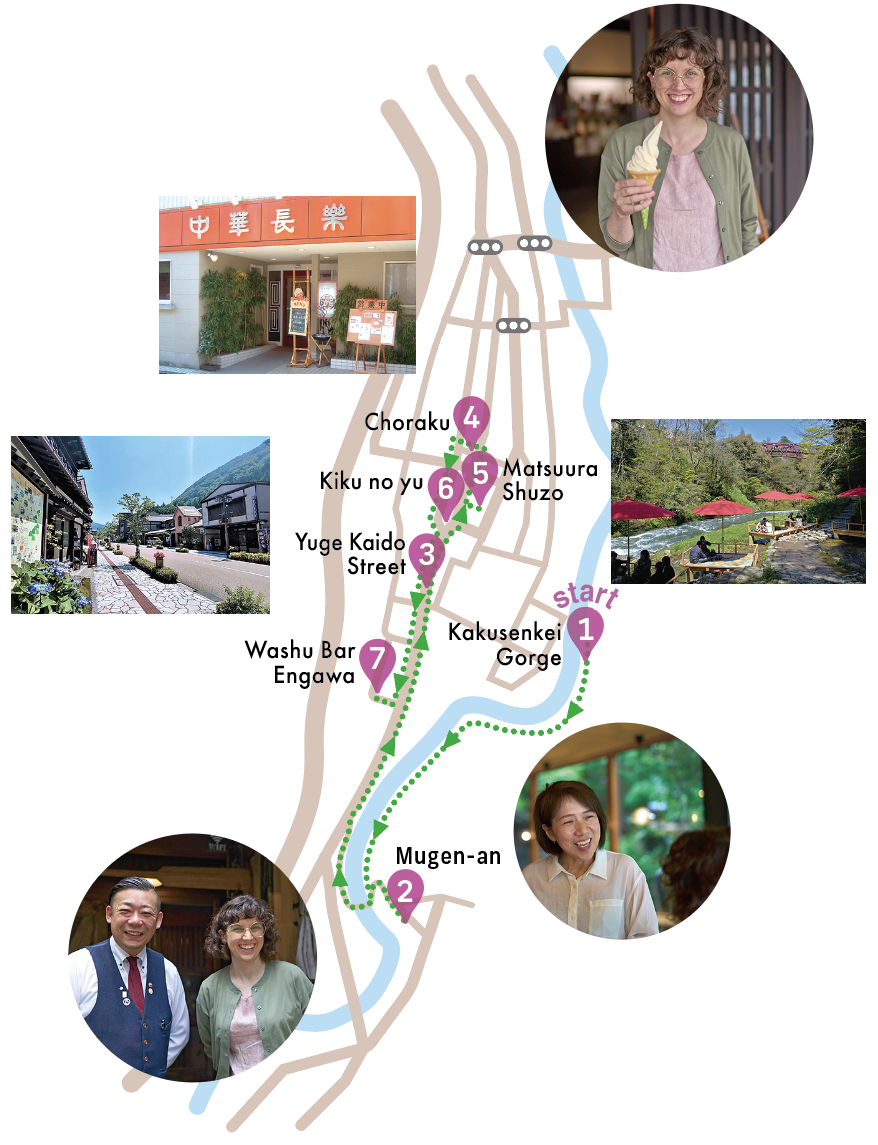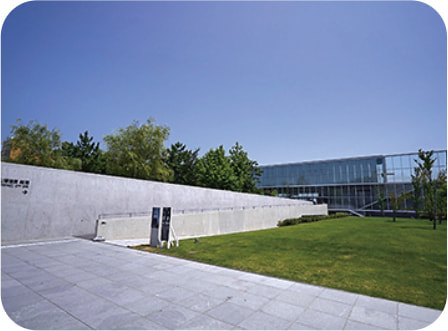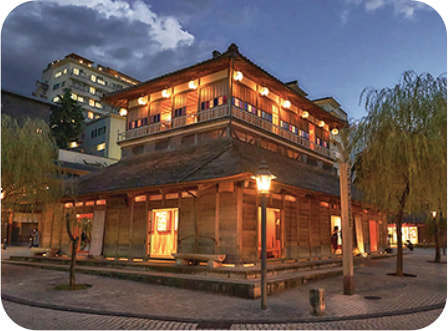
Author Hannah Kirshner fell in love with the rural town of Yamanaka in Kaga City and decided to live there

Author Hannah Kirshner fell in love with the rural town of Yamanaka in Kaga City and decided to live there
Yamanaka, a serene hot spring town in Kaga City, is nestled in lush green valleys where traditional ways of living flourish in harmony with nature. Hannah Kirshner, an American writer, resides in this quaint town. Hannah has always been fascinated by handcrafted objects. When she first came to Yamanaka in 2015 to apprentice at a sake bar, she discovered a wide variety of artists and craftsmen who shape the local community and culture. Falling in love with the place, she signed a contract with an American publisher and immersed herself in the local traditions, learning about sake brewing, woodworking, duck hunting, and charcoal making. By the time her book, Water, Wood, and Wild Things, was published in 2021, she’d decided to stay in the town.
Hannah lives in a charming house on the edge of the hot spring town, sandwiched between mountains and a river. In addition to writing for the New York Times and producing podcasts, she enjoys traditional culinary crafts at home. She grows her own vegetables, makes herbal teas, and pickles Japanese plums. As Hannah strolls through the streets, her elderly neighbors warmly greet her, often sparking friendly conversations. Though she may stand out as a foreign resident in this traditional community, she has truly found her place here.
Currently, Hannah is dedicating her time to renovating a 100-year-old traditional house next to her home. She’s tackling much of the work herself and plans to transform it into a kitchen studio for workshops, retreats, and community gatherings, although it may take some time.
“In contemporary America, nature is typically either protected and untouched, or exploited for resources,” says Hannah, “but in some places in Japan I could see another way, where humans are active participants in an ecosystem.” In preparation for her next book, she’s observing the revival and reinvention of farming and forestry practices that cooperate with nature.
Hannah Kirshner
Hannah grew up on a small farm outside Seattle and studied painting at the Rhode Island School of Design (RISD). Now based in Brooklyn and Yamanaka, she works as a freelance journalist for publications including the New York Times and The Atlantic. Her book, Water, Wood, and Wild Things, (which she also illustrated) explores traditional handcrafts and food-making in Yamanaka, intertwining these practices with the local landscape and way of life.
YAMANAKA WALKING MAP
A FEW OF HANNAH’S FAVORITE PLACES
Yamanaka is a charming town to explore, with scenic walking paths along the gorge and a main street lined with cafés and shops. Hannah has recommended a walking route that includes her favorite spots and frequently visited places.

❶Kakusenkei Gorge [鶴仙渓]
A scenic walking path follows the Daishoji River as it winds through the gorge. This path features three bridges, including the iconic Ayatori Bridge, and offers breathtaking views in every season. In the fall, you can admire the stunning autumn foliage while enjoying refreshments at the “Kawadoko” riverside café. Hannah delights in walking this path almost every day.
❷Mugen-an Samurai House [無限庵]
This was built by the Yokoyama family, who served as the Kaga Domain’s chief retainers for generations. It is now a museum showcasing the artistry and craftsmanship of wooden architecture. Hannah recommends visiting the café for matcha and sweets with a view of the gorge. A friendly lady warmly welcomes guests.
❸Yuge Kaido Street[ゆげ街道]
The main street is ideal for shopping, offering a variety of shops and galleries to explore. For craft enthusiasts, be sure to visit “GATOMIKIO/1,” a Yamanaka lacquerware shop, and “Amu Shop & Cafe,” which features a selection of specialty crafts and foods.
❹Choraku [長樂]
For lunch, Hannah recommends the shoyu ramen at Choraku. She says the soup is so light and nourishing she could drink it every day. This Chinese restaurant is famous for its handmade gyoza, so you must order those too!
❺Matsuura Shuzo [松浦酒造]
A sake brewery with a history spanning 14 generations. Hannah had the honor of being the first female brewer in its long history. You can enjoy a sake tasting (for a fee) or savor their soft serve ice cream made with sake lees.
❻Kiku no Yu Public Bathhouse [菊の湯]
A bustling communal bathhouse that is popular with locals and tourists alike. There is also a free outdoor foot bath, perfect for relaxing your tired feet after a day of exploring.
❼Washu Bar Engawa[和酒BAR 縁がわ]
This cozy sake bar with a stunning collection of local lacquerware is open day and night, making it easy to visit. The owner, Mr. Shimoki, first invited Hannah to visit Yamanaka. While working here, she learned about sake, met many people, and gradually adapted to life in Yamanaka.

❹Choraku
For lunch, Hannah recommends the shoyu ramen at Choraku. She says the soup is so light and nourishing she could drink it every day. This Chinese restaurant is famous for its handmade gyoza, so you must order those too!
❻Kiku no Yu Public Bathhouse
A bustling communal bathhouse that is popular with locals and tourists alike. There is also a free outdoor foot bath, perfect for relaxing your tired feet after a day of exploring.
❸Yuge Kaido Street
The main street is ideal for shopping, offering a variety of shops and galleries to explore. For craft enthusiasts, be sure to visit “GATOMIKIO/1,” a Yamanaka lacquerware shop, and “Amu Shop & Cafe,” which features a selection of specialty crafts and foods.
❼Washu Bar Engawa
This cozy sake bar with a stunning collection of local lacquerware is open day and night, making it easy to visit. The owner, Mr. Shimoki, first invited Hannah to visit Yamanaka. While working here, she learned about sake, met many people, and gradually adapted to life in Yamanaka.
❺Matsuura Shuzo
A sake brewery with a history spanning 14 generations. Hannah had the honor of being the first female brewer in its long history. You can enjoy a sake tasting (for a fee) or savor their soft serve ice cream made with sake lees.
❶Kakusenkei Gorge
A scenic walking path follows the Daishoji River as it winds through the gorge. This path features three bridges, including the iconic Ayatori Bridge, and offers breathtaking views in every season. In the fall, you can admire the stunning autumn foliage while enjoying refreshments at the “Kawadoko” riverside café. Hannah delights in walking this path almost every day.
❷Mugen-an Samurai House
This was built by the Yokoyama family, who served as the Kaga Domain’s chief retainers for generations. It is now a museum showcasing the artistry and craftsmanship of wooden architecture. Hannah recommends visiting the café for matcha and sweets with a view of the gorge. A friendly lady warmly welcomes guests.
Hop on the Shinkansen to Enjoy Onsen in Kaga City!

Connected to Kanazawa by the Hokuriku Shinkansen line, Kaga City is near both the mountains and the sea, features a historic castle town, and is dotted with traditional villages. The region’s diverse natural beauty supports seasonal ingredients, traditional crafts such as lacquerware and pottery, and Japan’s cherished hot springs. The three hot spring towns—Yamanaka, Yamashiro, and Katayamazu—attract many tourists, including families enjoying day-use baths and groups staying at ryokans to fully experience the hot springs and local cuisine. The journey from Kanazawa Station to Kagaonsen Station takes just 18 minutes by bullet train. Don’t miss the chance to enjoy Kaga’s renowned hot springs!

Katayamazu Onsen

Yamashiro Onsen

Yamanaka Onsen





